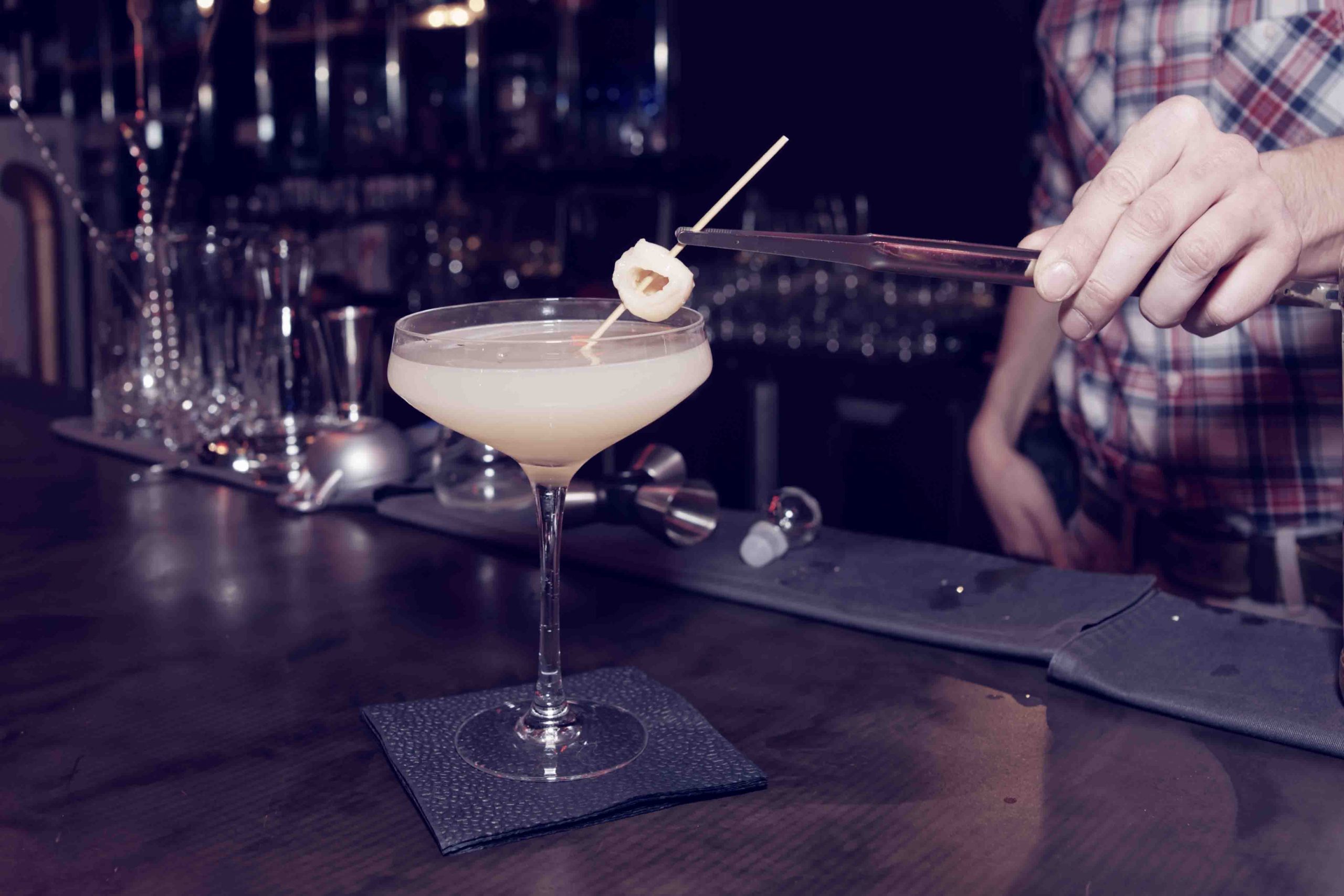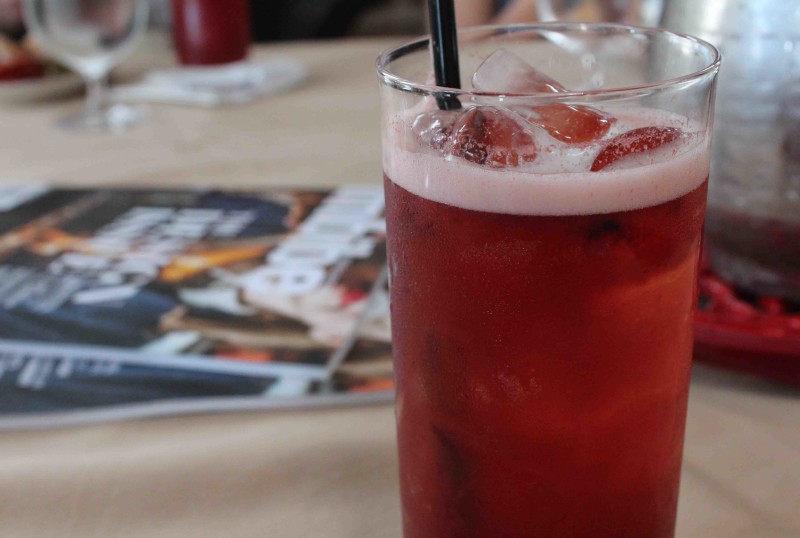


Cocktails are delicious, yes. And we continue to love and create them despite the damage they do to our bodies. But what actually happens when alcohol hits the body? What influences the effects of alcohol? And what if, with new ingredients and techniques, we could make healthy cocktail recipes that are great for both our health and our tastebuds?
Last month, at the Charleston Wine and Food Festival, we sat down with Pam Wiznitzer of Seamstress NY and Megan Deschaine of 492 Charleston for a conversation about the health benefits of certain alcohols, the ingredients that manipulate the bodily experience, color and edible components, and dual-application ingredients.
If you’re looking for healthy cocktail recipes to add to your menu, you first need to understand three things:
We asked Pam and Megan if alcohol can really be healthy. Or, at the very least, if it’s possible to make healthy cocktails. Wait till you see what they told us.

For the last few years, Pam has been researching the science behind booze. We asked her what alcohol does to the body once consumed.
“There are several factors that affect why and how you get drunk,” says Pam. Most drinkers are aware of these factors, but here are the biggest ones:
We now know the factors that affect how and why we get drunk. But before we discuss the key cocktail ingredients that might make healthier alternatives, let’s look at how alcohol does its damage.
About 20% of alcohol is absorbed through the stomach, and 80% through the small intestine. The alcohol then flows through the bloodstream. Approximately 90-95% is processed by the liver, which is why you need to take such good care of this organ. The remaining 5-10% is excreted through urine, breath, and sweat. But what you’re consuming, and the rate of consumption, is going to heavily affect how the toxin is both used and removed by your body.
We’re all aware of what happens when we drink too much, yet, for some reason, the notion of the hangover always lingers in the distance, only to appear when it’s too late. Here are some quick and dirty tips that might help.

Brushing aside these quick fixes, Pam and Megan swear by one overarching theme when it comes to balancing alcohol with health.
One word—quality.
“We always try to use the highest quality ingredients,” says Megan. That’s the secret to the perfect cocktail. Better quality ingredients mean better tasting drinks that are better for you. Not all ingredients or spirits are made the same.
These days, bartenders are putting as much thought and dedication into creating their menus as any Michelin starred chef would. “Distillers are working hard to improve the quality of their products, and a lot of research is being done by the bars who care,” says Megan. “There’s a lot being done to improve environmental and manufacturing ethics, but it’s you who’s consuming the produce, the flavors, and the health benefits, so it’s you who has to care about the quality.”
Think about the spirits you’re using at your bar. “Don’t buy spirits packaged in plastic. The product is probably stretched out and likely loaded with parts of the distillate that aren’t meant to be consumed,” says Megan.
So, apart from maintaining quality, what else can we do to make our cocktails healthier?

“Fortunately, we’re past the era of people using pre-made sours mix, which is basically just corn syrup,” says Pam. More bartenders are trying to add higher quality ingredients to their cocktails to provide something that’s better for their customers’ bodies than Rose’s lime juice or a simple syrup made of bad sugars.
So, when developing a new cocktail, it’s important to consider what’s really going into it. Are you using fresh ingredients? Are the spirits high quality?
These are the cocktail ingredients that Pam and Megan recommend.
As long as you use fresh fruit, you’ll find high amounts of vitamin C, calcium, and folate in citrus juice. There are great benefits from eating the entire fruit, so think about how you can use the whole thing. “Save the rind and dry it out to make candied orange peels!” Says Pam.
A classic application of citrus is in punch, where you’ll use the zest of the citrus. “Also, if you let citrus zest sit with granulated sugar for a few hours, the sugar will extract the oils, creating something that’s delicious, bright, and sweet. Plus, you’re getting maximum use out of that fruit,” says Megan. “Do this process with lemons, and you’re halfway to making limoncello.”
While not a citrus fruit, apples are an underrated ingredient. “They’re high in sugar, but the sugar is natural. You get a lift in your mood, a boost in vitamin C and antioxidants, and the fruit is cheap and accessible,” says Megan.
“I love berries as a cocktail ingredient, and, for me, the blackberry is king—it’s the highest antioxidant berry there is,” says Pam. “Black currants are also really good for you,” she explains. “Try adding black currant liqueur to a bit of champagne—delicious.”
Blueberries are a known superfruit, loaded with nutrients that prevent and fight brain cancer. “Take your mojito and muddle in some blueberries!” Megan suggests. Pam likes to take advantage of fruits when they’re in season, so she makes her own jam when berries are in bloom and uses it in her cocktails throughout the year. “It’s the easiest way to bring back flavor that you can’t get seasonally, and you’re controlling the sugar levels and maintaining the quality of your drinks year-round.”
Tea and alcohol have a historical relationship, dating back to a tradition when women incorporated booze into their diets through tea, mostly for alcohol’s “medicinal qualities”. Also, punch was originally made with tea instead of water because it adds all the flavor and nutrients without diluting and then adding the spices. “In my cocktails, I often use chai tea for its lovely cloves, cinnamon, and spices. Everyone loves it!” says Pam. Here are some other favorites.
On its own, vinegar sounds unappealing, but there are thousands of uses for vinegar as an application to health. Primarily, it aids digestion and proper functioning of the intestines and organs, so vinegar in cocktails has huge health benefits.
“For me, apple cider vinegar is the superior vinegar of choice. Its flavor is the best, and it’s proven to be more beneficial to your health. Vinegars are easy to make, great for your health, and in cocktails they make a great substitute for citrus—they taste so bright and zippy,” says Megan.
She also mentions the use of shrubs and gastriques. “These are basically vinegar syrups with a long shelf life. You can take those berries and make a shrub, and have it in your fridge for 3 – 4 weeks. Add rum and soda water, and that’s a delicious and healthy cocktail,” she explains. The same goes for homemade bitters and tinctures—making them yourself allows much more flexibility in creating healthy cocktails.
Pam has a flip on her menu at Seamstress, which uses the whole egg. “You can eat raw egg! It’s totally cool. We add balsamic vinegar to raise the acidity level and give it a kick,” she says. Adding whole eggs or egg whites to cocktails builds substance and sustenance, making the drink more filling and boosting its protein levels. “Much the same as using cream in cocktails, eggs stimulate a part of the brain that reacts to food and being fed, and the alcohol is easier to process,” she says.
There’s a reason why Italians often start a meal with an aperitif and end it with an amaro. Amaro is a bitter, low-proof spirit. “It’s great for settling stomachs, and because it’s made from different herbs or plants, the botanicals not only add a great bitterness to drinks but provide a lot of nutrients to the body,” says Pam.
“Fernet Branca is essentially a healthy alternative to Jagermeister. The San Francisco bartenders revived it, and now it’s known as ‘the bartender’s handshake,’” laughs Megan. It’s an exciting time for amaro and sherry, which are being used by some of the best bars in the country right now. “Campari, sweet vermouth, and soda water is a delicious and healthy way to start the night,” she says.
There are plenty of ways to incorporate vegetables into your cocktails. From blending to infusions and even sous-vide, adding vegetables to a drink will significantly boost its nutrient levels. Think beyond the Bloody Mary, and try experimenting with things like beets, carrots, and kale.
Pam and Megan both agree that no bar should ever buy simple syrup. “It’s so easy to make—half sugar, half water, a tiny bit of vodka to fortify it, shake it up, and you’re done. It’ll last 3 – 4 weeks in the fridge,” says Megan.
“Sugar is one of those things that people are afraid of the most, but it’s not actually that bad for you; it really depends on the type and quality of sugar you’re using.” It’s easy to make syrups healthier when they’re homemade. And this rule goes for just about any ingredient.
Want to get even more innovative with your syrups? “Boil some chai tea, add an equal amount of sugar, and you have a chai tea syrup. Genius. You can do this with ginger, rosemary, sage, thyme, berries, almost anything. Take half an ounce of that, add an ounce of vodka and some club soda, and that’s a refreshing, low calorie way to drink healthier,” says Pam.
So, what’s their advice for mixing the ultimate healthy cocktail?
“I think about what I like to eat,” says Pam. “I start with a baseline, with one ingredient. I think about those inherent flavors and what flavors I like together, and I try to produce that in my cocktails. It’s also important to find relatable ingredients based on the same gene families. Doing so extracts more flavor and will allow you to cook or mix seasonally.”
We’re feeling pretty thirsty right now.
For more tips about crafting the perfect cocktail, check out our Cocktail Recipe Video Series.
Need some help running your cocktail bar? Download our free eBook: Guide to Better Bar Management.

Schedule 15mins to chat with a product specialist
Start a FREE Trial Today! BevSpot offers full product education and account setup for all customers! No card Information needed!
